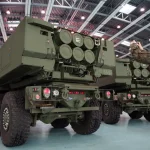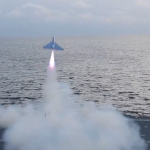![]() Beijing on Sept. 3 rolled out tanks, missiles, and warplanes in a grandiose military parade at Tiananmen Square, touting its display of “new” weaponry. But a closer look reveals that most of these so-called breakthroughs of China’s People’s Liberation Army’s (PLA’s) weaponry were either repackaged versions of older systems or crude knockoffs of Russian and American designs.
Beijing on Sept. 3 rolled out tanks, missiles, and warplanes in a grandiose military parade at Tiananmen Square, touting its display of “new” weaponry. But a closer look reveals that most of these so-called breakthroughs of China’s People’s Liberation Army’s (PLA’s) weaponry were either repackaged versions of older systems or crude knockoffs of Russian and American designs.
‘Flagship’ Missiles? More Like Rebadged Models
The missiles hyped as Beijing’s “strategic flagship” weapons included the air-launched Jinglei-1, the submarine-launched JL-3, and the land-based DF-61. A closer examination indicates that these are updates to existing models rather than breakthroughs in innovation.
Jinglei-1
Jinglei, whose acronym is JL, meaning “thunderbolt” in Chinese, was marketed as a long-range nuclear-capable air-launched ballistic missile (ALBM). In fact, the JL-1 is little more than a modified DF-21.
JL-3
The acronym in JL-3 stands for Julang, meaning “big wave” in Chinese. JL-3 is China’s latest submarine-launched ballistic missile (SLBM) that can reach 6,200 miles with three warheads.
DF-61
Presented as a replacement for the DF-41, the new model looked nearly identical—essentially a rebranded upgrade. The DF-41 has been discussed in military circles since 1997, with repeated claims by Chinese authorities that it is operational. Yet it was absent from major parades in 2015, 2017, and again this year, prompting speculation that the much-hyped DF-41 fell short of expectations, leading to this cosmetic switch.
Tanks and Ground Systems
The display of ground forces was no more reassuring.
China’s latest Type-100 tank made its debut at the parade. Still, it was positioned behind the upgraded Type-99B, which state media cited an expert describing as the real front-line system with “strong combat and survival capabilities.” The Type-100, with its 105 mm gun, is more of a light tank.
Global Times claims the Type 100 tank and its accompanying infantry fighting vehicle are designed for rapid deployment, deep tactical strikes, and urban combat, suggesting they are intended for use in street fighting during a potential invasion of Taiwan.

Copycat Aircraft
The airpower segment followed a similar pattern. China rolled out its KJ-600 carrier-based early warning aircraft, a copy of the U.S. Navy’s E-2 Hawkeye, “down to details,” according to the think tank Australian Strategic Policy Institute.
Imitation Drones
Unmanned systems made a strong showing at the parade. Still, nearly all bore a striking resemblance to their American counterparts.
Whether it’s the so-called new strike-recon drones, loyal wingman drones, or shipborne unmanned helicopters, their designs look a lot like those already in service or tested by the U.S. military. But when it comes to crucial specs such as speed and payload, they’re almost certainly a long way behind.
Most of these drones aren’t the disposable types seen constantly on the Russia–Ukraine battlefield. They’re more expensive, reusable models, but with lighter payloads. Figuring out how to control them effectively over long distances is still a new challenge for the Chinese regime.
Unmanned Naval Copycats
The United States has developed a wide range of unmanned surface ships, while its underwater drones are rarely seen in public. China, eager to imitate, has rolled out its own versions of unmanned ships and submarines. But it’s doubtful that the Chinese fully understand the systems inside or how to actually use them effectively.
Concluding Thoughts
The missiles and other hardware the Chinese regime rolled out were all offensive weapons, exposing the emptiness of Beijing’s “peaceful, defensive” rhetoric. But whether these weapons actually work as advertised is a big question mark.
At the same time, China’s defensive systems remain weak. Its air-defense missiles—copies of Russia’s S-300 and similar to Iran’s—struggle to intercept U.S. missiles or airstrikes, a fatal flaw that can’t be fixed.
In the end, the parade didn’t intimidate the world as intended. Instead, it highlighted the Chinese military’s shortcomings and stirred more resentment than respect.











